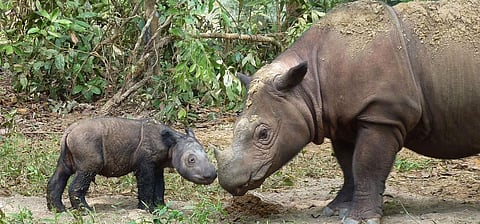

A veteran naturalist known for his expertise on the fauna of India’s Northeast has expressed hope that a couple of critically endangered Sumatran rhinos might still be present in India’s neighbourhood, in Myanmar.
“I still believe that there could be a few (2-3) wanderers left in Myanmar,” Anwaruddin Choudhury told Down To Earth (DTE).
The Sumatran rhino, the smallest of the five extant rhino species in the world, made headlines earlier this week, after Tam, the last male Sumatran in Malaysia, died at the Borneo Rhino Sanctuary in Tabin Wildlife Reserve, Lahad Datu in the state of Sabah, on the island of Borneo.
With Tam’s death, only one female, Iman, now survives within the boundaries of Malaysia. An estimated 80 Sumatran rhinos, the last of their kind, are thought to survive further south, in Indonesia, especially on the island of Sumatra and the Indonesian part of Borneo.
It is a sad ending to a species that was once found across Southeast Asia and west into Northeast India.
In 1997, Choudhury had published a paper titled The status of the Sumatran rhinoceros in north-eastern India.
“In the Indian subcontinent in the 19th century, the Sumatran rhinoceros occurred in parts of Assam, Nagaland, Manipur, Tripura, Mizoram, northern Bengal, Bhutan, Comilla and the Chittagong Hill Tracts (the latter two areas are now in Bangladesh),” the paper notes.
It continues, “The last two records for the subcontinent were in 1967, when a Sumatran rhinoceros was killed near Cox's Bazar in the Chittagong area and a rhinoceros was seen by local people in the Punikhal area of Sonai Reserved Forest of Cachar district, southern Assam.”
Choudhury also wrote about his travels in January 1996 to the Anko range in Manipur’s Ukhurul district and in June of the same year to Saramati in Nagaland. He had speculated that given the inaccessibility of the two areas and their thick forest cover, there could be a chance that there were some Sumatrans there.
“Yes, I visited and obtained that information. Today though, it is very unlikely that this would be the case,” he told DTE.
Interestingly, there are records of Sumatran rhinos being hunted by Naga, Kuki and Mizo hunters and chieftains, says Choudhury.
He is, however, more hopeful about Myanmar. Sumatrans were known to be found in the Tamanthi Wildlife Sanctuary across the Chindwin river in Myanmar, very near to the Indian border. “Considering the large size of forested areas in Myanmar and the fact that very few experts have visited it, there could be a chance,” he said.
He is also hopeful of the survival of the Indonesia Sumatrans. “They will definitely survive provided their habitat could be saved from the onslaught of timber cutters and oil palm plantations and no poaching takes place,” said Choudhury.